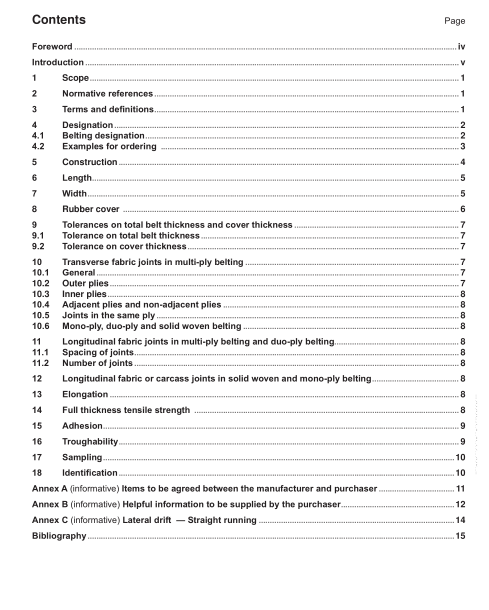ISO 14890:2013 pdf download.Conveyor belts — Specifcation for rubber- or plastics-covered conveyor belts of textile construction for general use
5 Construction
The carcass shall consist either of one or more plies of woven fabric or of solid woven fabric and shall be impregnated or coated with a rubber or plastics mix.
Where a breaker consisting of open mesh fabric, or cord fabric or cord layer, is placed between the cover and carcass, or is embedded in the cover for the purpose of carcass protection, such a layer shall be considered part of the cover thickness and shall not be counted as a fabric ply.
If a fabric pile is integrally woven with the carcass on either one or both of the surfaces of the carcass, it shall be considered part of the carcass thickness
.NOTE The external surfaces of the conveyor belt generally consist of a defned thickness and quality of elastomeric material. Belting can also be supplied with one or both surfaces consisting of bare or coated fabric, as appropriate for the conveyor design and intended duty.
6 Length
6.1 Belting that is ordered to an open-ended length shall be supplied subject to the tolerances specifed in Table 2.
6.2 The length of belting supplied in the spliced endless form shall be described by the term “net endless length”. The net endless length shall be supplied subject to the tolerances specifed in Table 3 when measured in accordance with ISO 16851.
It is recommended that purchasers, where placing orders for belting, specify a length of belting which includes the lengths required for testing and any additional lengths necessary for vulcanized joints.
7 Width
The width of the belting and its associated tolerance shall be one of those given in Table 4.
8 Rubber cover NOTE see Table 5.
8.1 If the rubber cover is designated as type H, D or L category it shall comply with the appropriate requirements of Table 5, and, after ageing for 168 h at 70 °C in accordance with ISO 188, the values obtained for tensile strength and elongation at break shall not vary from the original unaged values by more than 25 % of those values. 8.2 If the thickness of the rubber cover, as measured by the method described in ISO 583, is between 0,8 mm and 1,6 mm, the thickness of the test piece shall be the maximum obtainable and a tolerance of −15 % shall be permitted on the tensile strength and elongation values given in Table 5.
9 Tolerances on total belt thickness and cover thickness
9.1 Tolerance on total belt thickness If the mean of the 3, 5 or 8 values of total belt thickness, when measured by the method in ISO 583, is 10 mm or less, the maximum permissible difference between the maximum thickness and the minimum thickness shall be not greater than 1 mm.
For solid woven belting the maximum permissible difference shall be not greater than 1,5 mm. If the mean of the 3, 5 or 8 values of the total belt thickness, when measured by the method in ISO 583, is greater than 10 mm, the maximum permissible difference between the maximum thickness and the minimum thickness shall be not greater than 10 % of the mean value. For solid woven belting, the maximum permissible difference shall be < 15 %.
9.2 Tolerance on cover thickness
When measured by one of the methods described in ISO 583, the mean value of the cover thickness shall not be less than the specifed thickness by more than the amounts given in Table 6.
10 Transverse fabric joints in multi-ply belting
10.1 General
Transverse joints shall be at an angle of between 45° and 70° to the centre line of the belt.
10.2 Outer plies
Neither outer ply shall have more than one transverse joint per 100 m length of belt.
10.3 Inner plies
No inner ply shall have more than two transverse joints per 100 m length of belt.
10.4 Adjacent plies and non-adjacent plies
Transverse joints in adjacent plies and non-adjacent plies shall be not less than 3 m apart.ISO 14890 pdf download.ISO 14890-2013 pdf download
